Toledo Museum of Art
The Toledo Museum of Art is an internationally known art museum located in the Old West End neighborhood of Toledo, Ohio. It houses a collection of more than 30,000 objects.[1] With 45 galleries, it covers 280,000 square feet and is currently in the midst of a massive multiyear expansion plan to its 40-acre campus. The museum was founded by Toledo glassmaker Edward Drummond Libbey in 1901, and moved to its current location, a Greek revival building designed by Edward B. Green and Harry W. Wachter, in 1912.[2] The main building was expanded twice, in the 1920s and 1930s.[3] Other buildings were added in the 1990s and 2006. The Museum’s main building consists of 4 1/2 acres of floor space on two levels. Features include fifteen classroom studios, a 1,750-seat Peristyle concert hall, a 176-seat lecture hall, a café and gift shop.[4] The museum averages some 380,000 visitors per year and, in 2010, was voted America’s favorite museum by the readers of the pioneering visual arts website Modern Art Notes.
.jpg)
 | |

| |
| Established | 1901 |
|---|---|
| Location | 2445 Monroe Street Toledo, Ohio |
| Type | Art museum |
| Director | Adam Levine |
| Website | ToledoMuseum.org |
Effective July 1, 2019, John Stanley is serving as the interim director as the board conducts an international search for the 10th director.[5] After an extensive search, Adam Levine was announced as the Toledo Museum of Art's tenth director on January 30, 2020. Upon taking the helm of the Museum, TMA's board of directors unanimously passed a resolution that reclassified John Stanley's time as interim director as the Museum's tenth director, making Levine the eleventh director in the Toledo Museum of Art's history.[6]
Exhibits
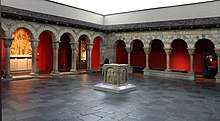
The museum holds major collections of glass art and of 19th- and 20th-century European and American art, as well as small but distinguished collections of Renaissance, Greek, Roman and Japanese art. Notable individual works include Peter Paul Rubens's The Crowning of Saint Catherine; Fragonard's Blind Man's Bluff; Vincent van Gogh's Houses at Auvers; minor works by Rembrandt and El Greco; and modern works by Willem de Kooning, Henry Moore, and Sol LeWitt. Other artists in the permanent collection include Holbein, Cole, Cropsey, Turner, Tissot, Degas, Monet, Cézanne, Matisse, Miró, Picasso, Calder, Bearden, Close, and Kiefer.
The Crowning of Saint Catherine
The museum bought the Rubens painting, The Crowning of Saint Catherine, from Albert Koppel in 1950.[7] Rubens had originally painted it for the church of the Augustinians in Mechelen (Malines) where it was installed in 1631. In the eighteenth century, the church authorities sold it to a dealer; in 1779, it was purchased by the 5th Duke of Rutland. It remained as part of the Rutland estate until 1911 when the 8th Duke of Rutland sold it to the German-Jewish banker and science entrepreneur Leopold Koppel. On Koppel's death in 1933, it was stolen by senior Nazi Hermann Göring for his private collection. At the end of World War II it was discovered by American troops in a salt mine and was eventually reclaimed, with several other paintings, by Leopold's son Albert.
The painting is among the 360 objects in the museum's collection that changed hands in Continental Europe during the Nazi era (1933-1945), according to the American Alliance of Museums Nazi-Era Provenance Internet Portal.[8]
Peristyle
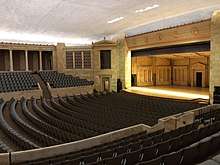
The Peristyle, a 1,750-seat concert hall in the east wing, is the principal concert space for the Toledo Symphony Orchestra and hosts the Museum's Masters series. Added in 1933, it was designed in classical style to match the museum's exterior. Seating is divided into floor and riser seating, with the riser seating arranged in a half-circle, similar to a Greek theater. At the back of the riser seating are 28 Ionic columns that give the concert hall its name.
A sculpture garden containing primarily postwar works was added in 2001; it runs in a narrow band along the museum's Monroe Street facade. (Earlier sculptures are on display in the interior).
Center for the Visual Arts and the Glass Pavilion
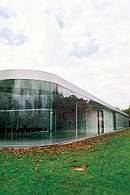
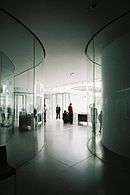
A Center for the Visual Arts, designed by Frank Gehry, was added in the 1990s. It includes the museum's library as well as studio, office, and classroom space for the art department of the University of Toledo.
In 2000, the museum chose the architectural firm of SANAA to design a new building to house the institution's glass collection. It was the firm's first commission in the United States. Front Inc. was appointed to assist the architects in developing technical concepts for the glass wall systems.[9] Much of the $30 million Glass Pavilion's financing came through the largest public fundraising drive in Toledo's history.[10] The building's curved glass walls were imported from China.[11]
The 74,000-square foot Glass Pavilion opened in August 2006 to considerable critical acclaim. ArtNet described it as "a striking symbol of cultural power. Intended to give pride of place to the institution’s collection of art glass." [12] In his review for The New York Times [13], Nicolai Ouroussoff wrote, "Composed with exquisite delicacy, the pavilion's elegant maze of curved glass walls represents the latest monument to evolve in a chain extending back to the Hall of Mirrors at Versailles." Ouroussoff commented on the pavilion's relationship with the museum's other buildings: "The Glass Pavilion is part of a loosely knit complex that includes the Beaux-Arts-style art museum here and the University of Toledo’s Center for the Visual Arts, designed by Frank Gehry. With its grand staircase leading up to a row of Ionic columns, the original museum is both a temple to art and a monument to the belief in high culture’s ability to uplift the life of the worker. The new structure’s low, horizontal form, fits in this context with remarkable delicacy, as if the architects hesitated to disturb the surroundings." The Pavilion is host to 700 public glass blowing exhibitions per year, as well as cutting edge community events such as (Re)New Year’s Days, a one-of-a-kind experience inspired by art, yoga, movement, and meditation, and Art of the Cut, a celebration of Black barbers and their roles as artists and men’s wellness advocates that was sponsored by ProMedica.[14]
The building showcases the museum's original glass collection and several new works, including one prominent glass sculpture by Dale Chihuly. [15]
Notable pieces
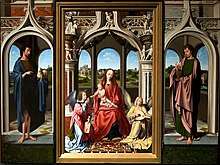 Master of the Morrison Triptych, c. 1500-1510
Master of the Morrison Triptych, c. 1500-1510 Lot and His Daughters by Artemisia Gentileschi, 1635-1638
Lot and His Daughters by Artemisia Gentileschi, 1635-1638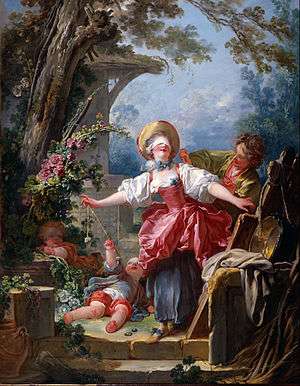 Blind Man's Bluff by Jean-Honoré Fragonard, c. 1750
Blind Man's Bluff by Jean-Honoré Fragonard, c. 1750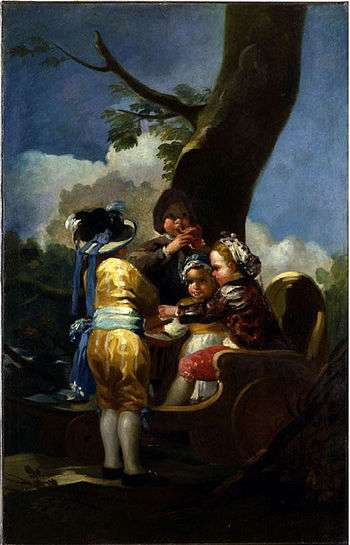 Children in a Chariot by Francisco Goya, 1778
Children in a Chariot by Francisco Goya, 1778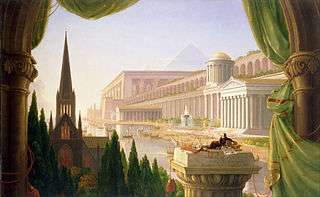 The Architect's Dream by Thomas Cole, 1840
The Architect's Dream by Thomas Cole, 1840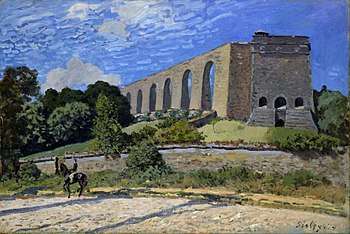 The Aqueduct at Marly by Alfred Sisley, 1874
The Aqueduct at Marly by Alfred Sisley, 1874 Road at Wargemont by Pierre-Auguste Renoir, 1879
Road at Wargemont by Pierre-Auguste Renoir, 1879 Wheat Fields with Reaper by Vincent van Gogh, 1888
Wheat Fields with Reaper by Vincent van Gogh, 1888 Houses at Auvers by Vincent van Gogh, 1890
Houses at Auvers by Vincent van Gogh, 1890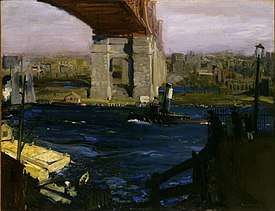 The Bridge, Blackwell's Island by George Bellows, 1909
The Bridge, Blackwell's Island by George Bellows, 1909 Window by Frank Lloyd Wright, 1912
Window by Frank Lloyd Wright, 1912
References
- "About". Toledo Museum of Art.
- "Historic Date Observed Jan. 17 at Toledo Museum of Art" (PDF). The Toledo Museum of Art. January 5, 2012. Archived from the original (PDF) on June 10, 2012. Retrieved January 17, 2012.
The Museum's iconic building […] at 2445 Monroe St. opened to the public for the first time […] on Jan. 17, 1912.
- Putney, Richard: "Medieval Art, Medieval People", pages 5-7. Toledo Museum of Art, 2002.
- https://www.toledomuseum.org/sites/default/files/028-037_toledo.pdf
- "Toledo Museum of Art Board names John Stanley as Interim Executive Director". The Toledo Museum of Art. March 29, 2019. Retrieved July 1, 2019.
- "Adam Levine takes the helm of TMA amid a pandemic". Toledo Blade. May 2, 2020. Retrieved May 2, 2020.
- "The Crowning of Saint Catherine". Toledo Museum of Art. Retrieved January 12, 2016.
- American Alliance of Museums Nazi-Era Provenance Internet Portal
- Front Inc. – official website
- http://www.artnet.com/magazineus/reviews/davis/davis8-30-06.asp
- Areddy, James T. (August 29, 2010). "In Toledo, the 'Glass City,' New Label: Made in China - WSJ.com". Online.wsj.com. Retrieved September 8, 2012.
- "Glass Houses - artnet Magazine". www.artnet.com. Retrieved December 2, 2019.
- Ouroussoff, Nicolai (August 28, 2006). "A Crystal Showcase Reflects a City's Glass Legacy". The New York Times. ISSN 0362-4331. Retrieved December 2, 2019.
- https://www.toledomuseum.org/sites/default/files/tmoa19_009_p_annual_report_final_web.pdf
- "April 8 Art Minute: Dale Chihuly, "Campiello del Remer #2"". The Toledo Museum of Art. April 8, 2016. Retrieved December 2, 2019.
External links
| Wikimedia Commons has media related to Toledo Museum of Art. |